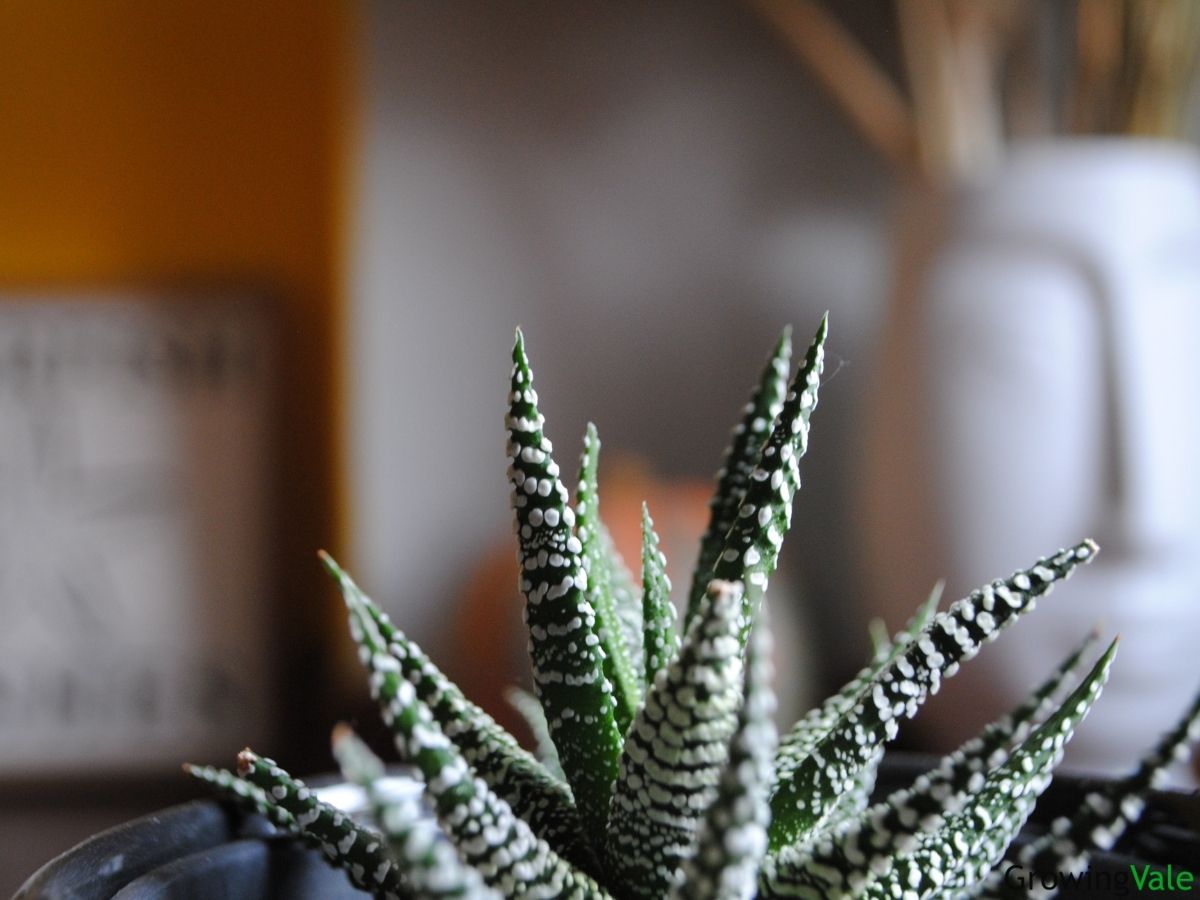Haworthia attenuata is one of the most well-known succulents. It is often confused with Haworthia fasciata, with which it shares many of its features.
Here’s the main difference between the two: H. attenuata has protuberances on the inner surface of its leaves, making it highly textured. H. fasciata, on the other hand, has smooth inner leaves.
The stripes along the outer surface of each leaf are what make this plant truly special. They are stark white in color, highly contrasting the rest of the light to dark green leaves. You’ll have to look closely to truly appreciate the striped pattern as this species seldom grows to more than 4 inches (10 cm) tall.
History
This species has recently been reclassified as a Haworthiopsis, though it is still widely regarded as a Haworthia. You’ll find that most succulent nurseries will retain this old genus name.
Native to the Eastern Cape Province of South Africa, the zebra plant is resistant to drought, but will relish in generous watering sessions each summer. When conditions are optimal, it produces lengthy flower stalks with delicate white blooms.
Plant Facts
| Scientific name | Haworthiopsis attenuata (previously Haworthia attenuata) |
| Common names | Zebra Plant, Zebra Haworthia, Haworthia Zebra |
| Genus | Haworthiopsis |
| Family | Asphodelaceae |
| Height | 4-8 inches |
| Width | 4 inches |
| USDA Plant Hardiness Zone | 9-10 |
| Origin | South Africa |
| Flower colors | White |
| Blooming season | Summer |
| Plant/Flower special features | Striped foliage |
How to Plant and Grow Zebra Haworthia
H. attenuata becomes established fairly quickly in small porous pots with a well-draining substrate. It is seldom cultivated from seed as germination times can be lengthy and not all seeds are viable. Instead, plant nurseries tend to enlarge their zebra plant stock by rearing mother plants that produce offsets each year.
How to Propagate Haworthia attenuata
Offsets, also frequently referred to as pups, should only be excised from the main plant once they reach a width of at least 1 inch. This improves the likelihood of survival and rapid acclimation after being transplanted. Pups should not be exposed to intense outdoor conditions.
To remove pups without damaging their root systems, it would be prudent to uproot the entire mother plant. It should be easy to grab hold of the base of each pup and gently wiggle them to cleanly come off of the main stem.
Plant the Zebra Haworthia in smaller, shallow pots to begin with – even a recycled yogurt cup with holes on the bottom should suffice! As they increase in size, gradually repot them into larger containers.
Haworthiopsis attenuata Care and Maintenance
Here’s what you need to know when it comes to caring for Haworthia:
Soil
You can create your own well-draining succulent mix with sand, gravel, perlite, pumice, and a small amount of sterilized compost. This mix should allow water to rapidly stream out of the bottom hole of the pot. H. attenuata will also fare well in store-bought soil mixes made for cacti.
Water
In summer, water can be provided on a weekly schedule or whenever the soil has dried out completely. Zebra plants placed outdoors will require a more frequent watering schedule. Pots moved indoors for winter should be watered sparingly. Excess water in catch plates must always be disposed of.
Fertilizer
H. attenuata does not require fertilizer, but may benefit from a low-concentration mixture made for cacti or succulents during summer.
Sunlight
At least 6 hours of filtered sunlight is best for this species. Full sun exposure can scorch the tips of its tapered leaves, especially if the plant has not been acclimated beforehand.
Temperature and Humidity
H. attenuata can tolerate temperatures that dip down to 50F in the winter. Its leaves and roots can become injured when exposed to lower temperatures. It can tolerate a wide range of humidity levels as long as its other requirements are optimized.
Pruning
Only the flower stalks of H. attenuata need to be cut down whenever the blooms are spent.
Repotting and Transplanting
Try to repot your Zebra Haworthia plant every 2-3 years or whenever it has spread to the pot’s width. Offset removal also provides the opportunity to repot your plant.
Pests and Diseases
H. attenuata is resistant to most pests and diseases, but it can succumb to root rot. This is usually indicated by yellowing leaves. When a zebra plant has rotten roots, a light touch can make the entire plant fall over.
Uses of Haworthia attenuata
Haworthia Zebra plants are great for succulent gardens and as a plant of indoor interest.
Common Varieties
As the most popular haworthia, this species has a lot of cultivars! Some of the most attractive ones are listed below.
- H. attenuata var. radula
- H. attenuata var. glabrata
- H. attenuata ‘Variegata’
- H. attenuata ‘Crazed Glaze’
Conclusion
H. attenuata is the most cultivated of all Haworthia succulent types because beginner gardeners can easily grow this plant indoors.

